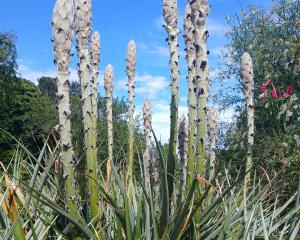Long-lived woodland plants, trilliums have great appeal, says Gillian Vine.
Woodland plants that need cold winters to do well, trilliums flower for up to a month in spring.
In the right spot, they are long-lived, with claims that they will outlast the gardener, growing for 70 years and getting better every season (unlike the gardener).
About 80% of the 50 trillium species are North American natives, the remainder coming from east Asia, mainly Japan.
The common name wake robin, now widely used for all trilliums, really refers to Trillium grandiflorum, which flowers in North America when the first robins appear in spring.
As the ''tri'' part of the name indicates, three is the distinguishing mark of a trillium, as leaves, petals and sepals (the parts that protect flower buds) are all arranged in trios.
There are two main types, those that have flowers on stems (pedicels), such as pretty little T. rivale and T. nivale, and the sessiles, like popular T. grandiflorum and T. chloropetalum, which have blooms without stalks.
Some, especially red-flowered species, have attractively blotched leaves.
The plants die down in late summer to re-emerge early in spring, then produce red, pink, white, speckled or yellow blooms.
Trilliums are extremely hardy and perform best if they get some winter chilling. Almost all are single and set seed, which can be sown as soon as it is ripe.
Depending on the species, some will germinate the following spring but with others, it may take five years for seedlings to appear and a further three years for the rhizomes to reach flowering size.
Much admired for their gardenia-like flowers, double trilliums are sterile, as their reproductive organs have been replaced by additional petals.
This means they can be propagated only by dividing plants, a slow process, which is why these sought-after plants can cost up to $US90 ($NZ136) each in the United States.
Most doubles are white, although mature flowers may have a pink tinge.
Unlike North America, where the bulk of trilliums offered for sale are gathered in the wild, New Zealand's trilliums are nursery-grown as we have no endemic species.
One grower is Jamie Urquhart, of Hawea, whose specialty is double white T. grandiflorum Flore Pleno, sometimes known as Snowbunting, the name under which it was shown at London's Chelsea Flower Show in 1960.
A natural mutant of T. grandiflorum, Flore Pleno was first found in New York state in the 1920s, although others with slightly different petal arrangements have subsequently been found growing wild in other parts of the US.
Like the species, the doubles are among the last to flower, blooming for a month from the end of September or early October.
Jamie's interest in the plant goes back 35 years ago, when he and his wife were given a Flore Pleno by her mother.
It cost $35, he recalled, the price reflecting the time it takes for nurseries to propagate the plants.
''When we were given the trillium, quite a lot of New Zealand plants were being exported and I thought of [doing it],'' Jamie said.
He explained that a trillium could be divided into five after about five years, so producing commercial quantities of flowering-sized specimens from that first plant had been ''a slow process''.
Now that he has ''a good number'' of flowering-sized specimens, he is planning to release the first batch of three- to five-year-old plants this year.
To do so, the retired nurseryman, who owned Hawea's Nook Road Nursery, is setting up a small business, Trillium Nook, which will specialise in T. grandifolium Flore Pleno.
For details, email trilliumnook@yahoo.com. Plants will be sent out in late summer or early autumn when they are dormant.
Grow trilliums in moist, well-drained soil in a shaded or partly shaded area, such as under deciduous trees or beside a solid fence.
Most trilliums like neutral or acid soil, so do well alongside rhododendrons.
An exception is the little early-flowering snow trillium (T. nivale) whose North American habitat is chalky outcrops near streams and rivers.
In nature, fallen leaves give the plants nourishment and protect them from extremely harsh winter conditions, so a mulch of leaves at the end of the growing season is recommended.
However, the most important growing tip from Jamie Urquhart is never to pick the flowers.
If you do, the plant will lose its energy and flower poorly (if at all) next season.












